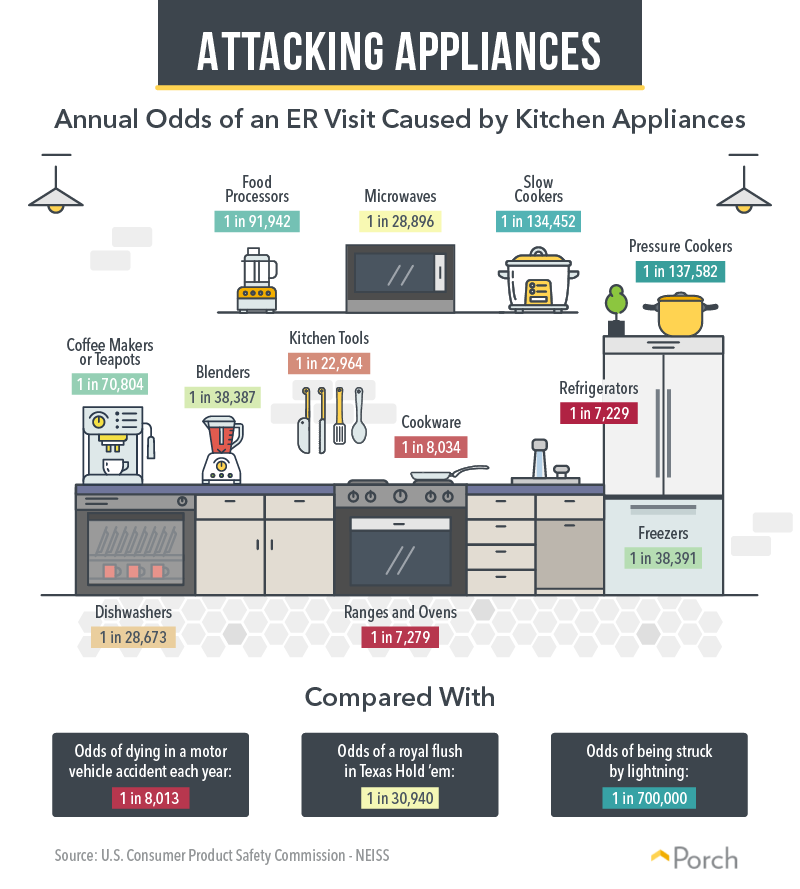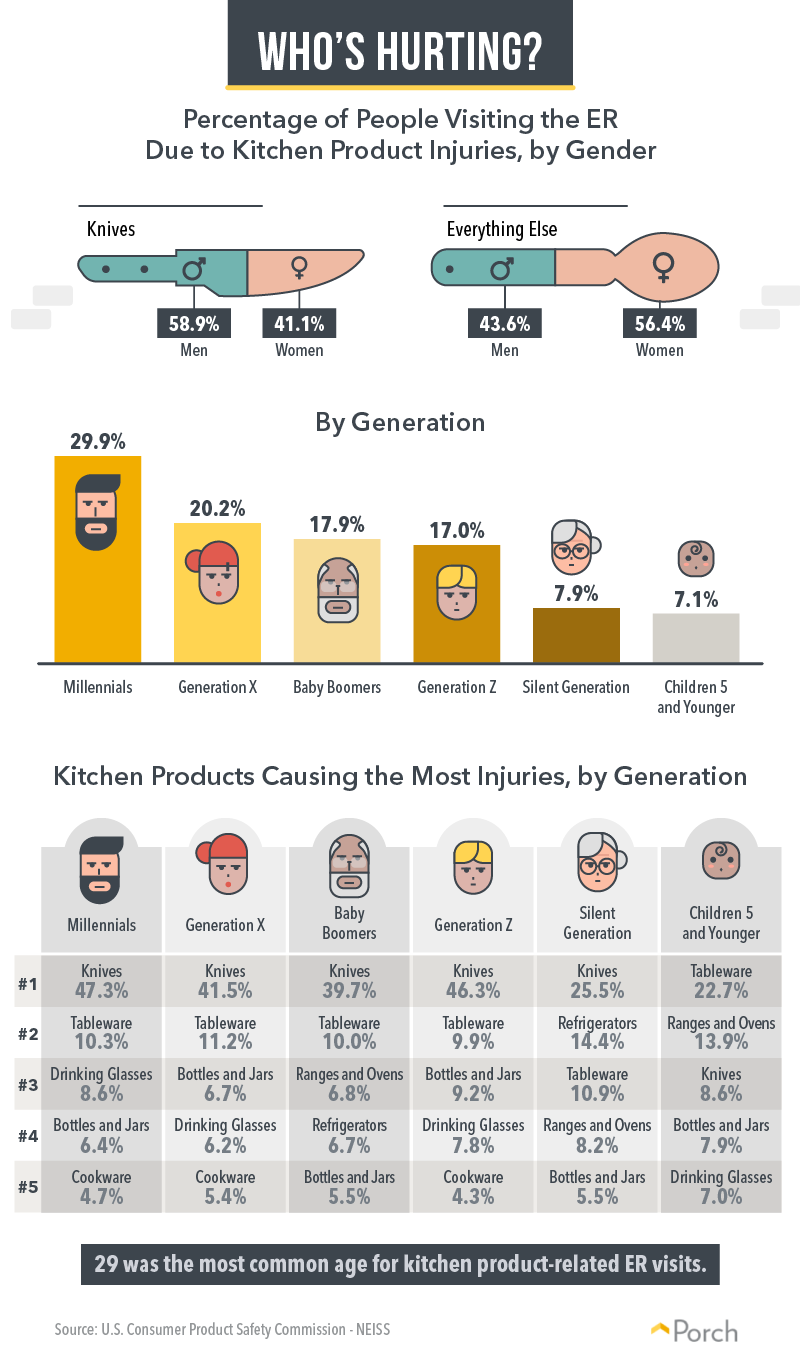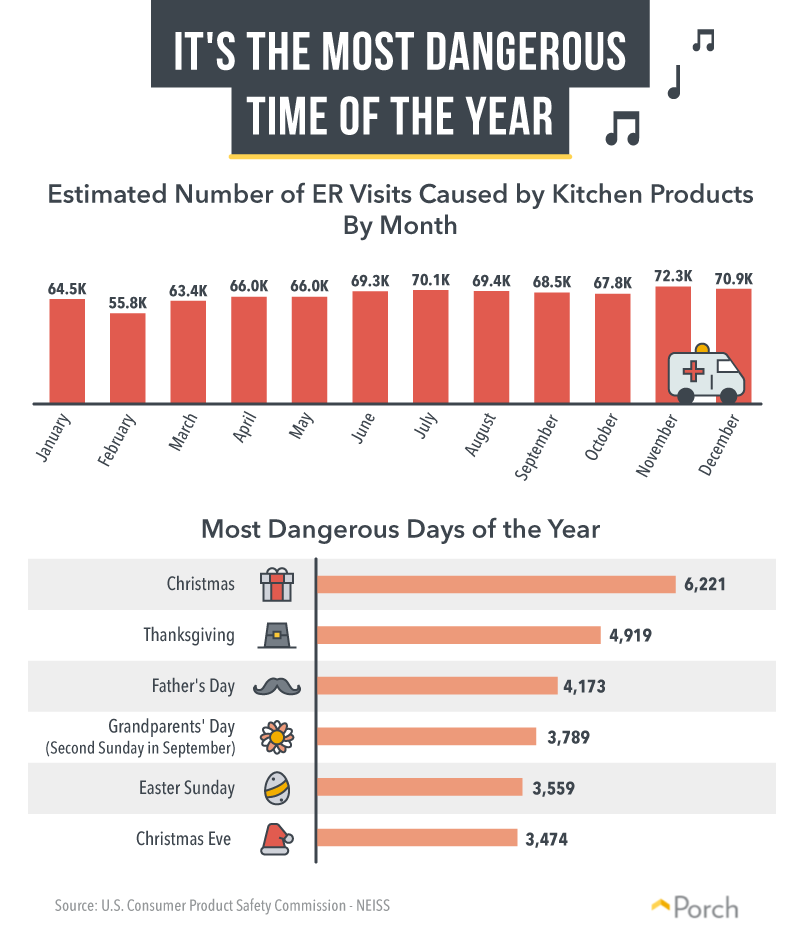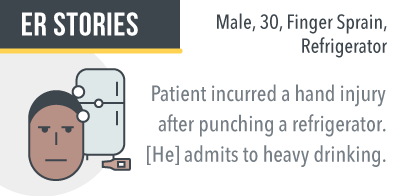
 For casual cooks and experienced chefs alike, the kitchen presents more hazards than imagined. Sure, there’s the occasional eye-catching headline declaring culinary danger: Avocado-related injuries are on the rise, and turkey fryers are Thanksgiving’s deadliest tradition. But even the modest meals we prepare each day can put us in peril. Consider the risks you readily accept in the kitchen but would refuse to put up with elsewhere in your home. It’s not like each trip to your laundry room includes contusions, cuts, and broken glassware. Some will say this account of kitchen danger is overblown, rejecting calls for greater safety precautions. So we determined to find some cold hard data attesting to injuries caused by products typically found in the kitchen. We analyzed thousands of records from the National Electronic Injury Surveillance System, a detailed database of emergency room visits and the injuries that prompted them. Our findings demonstrate just how threatening the kitchen can be, and which accidents occur most often. To see your chances of getting by kitchen products, keep reading.
For casual cooks and experienced chefs alike, the kitchen presents more hazards than imagined. Sure, there’s the occasional eye-catching headline declaring culinary danger: Avocado-related injuries are on the rise, and turkey fryers are Thanksgiving’s deadliest tradition. But even the modest meals we prepare each day can put us in peril. Consider the risks you readily accept in the kitchen but would refuse to put up with elsewhere in your home. It’s not like each trip to your laundry room includes contusions, cuts, and broken glassware. Some will say this account of kitchen danger is overblown, rejecting calls for greater safety precautions. So we determined to find some cold hard data attesting to injuries caused by products typically found in the kitchen. We analyzed thousands of records from the National Electronic Injury Surveillance System, a detailed database of emergency room visits and the injuries that prompted them. Our findings demonstrate just how threatening the kitchen can be, and which accidents occur most often. To see your chances of getting by kitchen products, keep reading.
Instruments of injury

 Knives can inflict much harm, but the sheer volume of injuries they cause annually is stunning. More than 322,000 emergency room visits stemmed directly from knives in 2017. All other objects accounted for far fewer accidents, although ceramics and glass posed a significant threat as well in the form of broken tableware and glasses and jars. Refrigerators also proved menacing, causing more than 44,000 injuries. Among these fridge-induced ailments, the most common was internal head injury—likely the result of getting accidentally bludgeoned when another person opens the door or perhaps when putting away groceries in both the fridge and freezer simultaneously. Ranges and ovens came in slightly behind refrigerators, and cookware contributed roughly 40,000 injuries, with hand burns being the most common ailment suffered from each. Microwaves also accounted for over 11,000 injuries. Even some of the most ostensibly innocuous kitchen items produced thousands of injuries, such as plastic bags. Because the leading injury associated with this object was finger lacerations, we can assume a sharp object poked through the plastic. Conversely, some items that seem relatively threatening caused fewer than 3,500 ER visits annually, such as can and bottle openers. Those scared by the “This Is Us” slow cooker storyline will happily note those appliances cause relatively few injuries in reality.
Knives can inflict much harm, but the sheer volume of injuries they cause annually is stunning. More than 322,000 emergency room visits stemmed directly from knives in 2017. All other objects accounted for far fewer accidents, although ceramics and glass posed a significant threat as well in the form of broken tableware and glasses and jars. Refrigerators also proved menacing, causing more than 44,000 injuries. Among these fridge-induced ailments, the most common was internal head injury—likely the result of getting accidentally bludgeoned when another person opens the door or perhaps when putting away groceries in both the fridge and freezer simultaneously. Ranges and ovens came in slightly behind refrigerators, and cookware contributed roughly 40,000 injuries, with hand burns being the most common ailment suffered from each. Microwaves also accounted for over 11,000 injuries. Even some of the most ostensibly innocuous kitchen items produced thousands of injuries, such as plastic bags. Because the leading injury associated with this object was finger lacerations, we can assume a sharp object poked through the plastic. Conversely, some items that seem relatively threatening caused fewer than 3,500 ER visits annually, such as can and bottle openers. Those scared by the “This Is Us” slow cooker storyline will happily note those appliances cause relatively few injuries in reality.
Menacing machines

 Putting aside manual tools for a moment, which culinary machines harm people most? The aforementioned refrigerator surpassed all other appliances in this regard: Your odds of getting hurt by one are roughly 1 in 7,200. One’s odds of injury by ranges and ovens were only slightly less, followed by the chances of getting hurt by cookware. Those chances might seem slim until compared to other common threats: One in 8,013 people die in a motor vehicle crash each year. Risk of injuries involving kitchen tools, microwaves, and dishwashers all ranged between 1 in 22,000 and 29,000—more likely than getting a royal flush in Texas Hold ‘em poker. Even the least likely appliance injuries occurred more frequently than some other dangers, such as being struck by lightning. In some cases, low injury odds were attributable to the rarity of a given appliance rather than its relative safety. Deep fryers, for example, can have explosive consequences but are less commonly owned and used than essential appliances such as dishwashers.
Putting aside manual tools for a moment, which culinary machines harm people most? The aforementioned refrigerator surpassed all other appliances in this regard: Your odds of getting hurt by one are roughly 1 in 7,200. One’s odds of injury by ranges and ovens were only slightly less, followed by the chances of getting hurt by cookware. Those chances might seem slim until compared to other common threats: One in 8,013 people die in a motor vehicle crash each year. Risk of injuries involving kitchen tools, microwaves, and dishwashers all ranged between 1 in 22,000 and 29,000—more likely than getting a royal flush in Texas Hold ‘em poker. Even the least likely appliance injuries occurred more frequently than some other dangers, such as being struck by lightning. In some cases, low injury odds were attributable to the rarity of a given appliance rather than its relative safety. Deep fryers, for example, can have explosive consequences but are less commonly owned and used than essential appliances such as dishwashers.
Affliction in the kitchen

 The body parts we use most when cooking can be subject to the greatest peril: Over 63 percent of kitchen knife-related injuries involved fingers. These facts should justify more caution for anyone when cutting, but the list of common accidents doesn’t end there. Feet also succumbed to injuries quite frequently, most often because of drinking glasses which may break into sharp pieces when dropped. Bottles and jars were the most common cause of injury for several parts of the body, including the toe and eye—and even the pubic region. Faces were injured most often by tableware, such as bowls and mugs. Injuries to other parts of the head frequently stemmed from the refrigerator, a fact that further supports our aforementioned theses.
The body parts we use most when cooking can be subject to the greatest peril: Over 63 percent of kitchen knife-related injuries involved fingers. These facts should justify more caution for anyone when cutting, but the list of common accidents doesn’t end there. Feet also succumbed to injuries quite frequently, most often because of drinking glasses which may break into sharp pieces when dropped. Bottles and jars were the most common cause of injury for several parts of the body, including the toe and eye—and even the pubic region. Faces were injured most often by tableware, such as bowls and mugs. Injuries to other parts of the head frequently stemmed from the refrigerator, a fact that further supports our aforementioned theses.
The kitchen’s victims

 When we considered kitchen product injury patterns among various demographics, we found men experienced the majority of knife-related injuries, whereas women accounted for more than half of all other accidents. Interestingly, millennials significantly outpaced any other age group in injury frequency. Perhaps we can chalk this trend in culinary accidents up to digital distraction. Research suggests millennials love cooking but can’t put their phones down while at it. Of course, even the youngest people are exposed to kitchen threats occasionally. For children 5 and younger, tableware posed the greatest risk, followed by ranges and ovens. Knives accounted for the largest share of injuries sustained by every other age group, but some interesting differences emerged among the generations as well. For the oldest cohort, the silent generation, a disproportionate number of accidents were refrigerator-related. Perhaps run-ins with these appliances create more serious injuries for older individuals, whereas younger folk may skip the ER visit.
When we considered kitchen product injury patterns among various demographics, we found men experienced the majority of knife-related injuries, whereas women accounted for more than half of all other accidents. Interestingly, millennials significantly outpaced any other age group in injury frequency. Perhaps we can chalk this trend in culinary accidents up to digital distraction. Research suggests millennials love cooking but can’t put their phones down while at it. Of course, even the youngest people are exposed to kitchen threats occasionally. For children 5 and younger, tableware posed the greatest risk, followed by ranges and ovens. Knives accounted for the largest share of injuries sustained by every other age group, but some interesting differences emerged among the generations as well. For the oldest cohort, the silent generation, a disproportionate number of accidents were refrigerator-related. Perhaps run-ins with these appliances create more serious injuries for older individuals, whereas younger folk may skip the ER visit.
Hazardous for the holidays

 Food is integral to holiday festivities, but cooking on special occasions can be a recipe for disaster. Christmas witnessed more than 6,200 injuries, and Thanksgiving saw nearly 5,000. The circumstances of these accidents aren’t hard to imagine: People are preparing multiple dishes simultaneously, distracted by hosting duties, or possibly having a few drinks in the holiday spirit. Interestingly, Father’s Day accounted for roughly 4,100 injuries as well. Perhaps thankful children and wives attempt to cook a nice meal for the fathers in their lives, and their kindness results in injury. Due, in part, to the holiday trend, injuries did spike in November and December. But they also saw increased numbers during the summer months, including more than 70,000 in July. One explanation could relate to school schedules: With children around the house during these vacation months, more members of the household are present to incur injury.
Food is integral to holiday festivities, but cooking on special occasions can be a recipe for disaster. Christmas witnessed more than 6,200 injuries, and Thanksgiving saw nearly 5,000. The circumstances of these accidents aren’t hard to imagine: People are preparing multiple dishes simultaneously, distracted by hosting duties, or possibly having a few drinks in the holiday spirit. Interestingly, Father’s Day accounted for roughly 4,100 injuries as well. Perhaps thankful children and wives attempt to cook a nice meal for the fathers in their lives, and their kindness results in injury. Due, in part, to the holiday trend, injuries did spike in November and December. But they also saw increased numbers during the summer months, including more than 70,000 in July. One explanation could relate to school schedules: With children around the house during these vacation months, more members of the household are present to incur injury.
Safety—and style—where you cook
 Although our findings indicate things can get dangerous quickly in the kitchen, don’t let fear of injury keep you from cooking. With the proper precautions in place, even the most inexperienced aspiring chef can cook with confidence. Leave yourself plenty of time when preparing your meals, so you don’t hurt yourself due to rushing, follow a few family guides to kitchen safety. And don’t compromise on equipment: Dull knives and broken appliances can lead to disaster. No dish is worth sacrificing your safety, but these tips will keep you eating—and cooking—healthily. Whether you’ve been looking to upgrade your kitchen style for a while or need repairs following an accident of your own, Porch is your place to find trusted professionals. Use our site to get great rates from experienced home improvement specialists, and explore our price estimates for a range of popular projects. To start checking items off your home improvement to-do list, check us out today.
Although our findings indicate things can get dangerous quickly in the kitchen, don’t let fear of injury keep you from cooking. With the proper precautions in place, even the most inexperienced aspiring chef can cook with confidence. Leave yourself plenty of time when preparing your meals, so you don’t hurt yourself due to rushing, follow a few family guides to kitchen safety. And don’t compromise on equipment: Dull knives and broken appliances can lead to disaster. No dish is worth sacrificing your safety, but these tips will keep you eating—and cooking—healthily. Whether you’ve been looking to upgrade your kitchen style for a while or need repairs following an accident of your own, Porch is your place to find trusted professionals. Use our site to get great rates from experienced home improvement specialists, and explore our price estimates for a range of popular projects. To start checking items off your home improvement to-do list, check us out today.
Methodology
To create the graphics and information shown above, we examined U.S. Consumer Product Safety Commission’s National Electronic Injury Surveillance System (NEISS) data for all products typically found in a kitchen. Using weighted values given by the NEISS, we estimated the number of injuries per product. Some grouping was necessary for similar objects. To compile this data, we relied solely on 2017 data. Because the data are compiled using a sampling system and are estimated, figures may be inexact.
Sources
https://www.cbsnews.com/news/avocado-hand-injuries-on-the-rise/ http://www.newsweek.com/car-accidents-and-cooking-fires-heres-how-youll-probably-die-thanksgiving-718624 https://www.cpsc.gov/Research–Statistics/NEISS-Injury-Data https://www.consumerreports.org/slow-cookers/why-the-slow-cooker-fire-on-this-is-us-is-actually-unlikely/ https://www.usda.gov/media/blog/2017/11/06/dont-make-turkey-frying-disastrous-situation-thanksgiving https://www.cnn.com/2018/01/14/world/plastic-straws-ban-campaigns/index.html https://nypost.com/2017/10/03/why-food-obsessed-millennials-suck-at-cooking/ https://www.menshealth.com/trending-news/a19546831/how-to-sharpen-kitchen-knives/
Fair Use Statement
Feel free to share our images and information with our own audience for noncommercial purposes, and help us keep America’s kitchens safe! When you do, please attribute us appropriately with a link to this page. It’s not quite getting hit in the head by the refrigerator door, but not getting credit hurts all the same.
